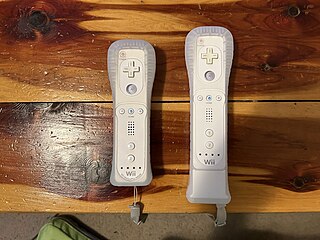Related Research Articles

Virtual reality (VR) is a simulated experience that employs 3D near-eye displays and pose tracking to give the user an immersive feel of a virtual world. Applications of virtual reality include entertainment, education and business. VR is one of the key technologies in the reality-virtuality continuum. As such, it is different from other digital visualization solutions, such as augmented virtuality and augmented reality.

A head-mounted display (HMD) is a display device, worn on the head or as part of a helmet, that has a small display optic in front of one or each eye. HMDs have many uses including gaming, aviation, engineering, and medicine.

In computing, a motion controller is a type of input device that uses accelerometers, gyroscopes, cameras, or other sensors to track motion.

Oculus Rift is a discontinued line of virtual reality headsets developed and manufactured by Oculus VR, a virtual reality company founded by Palmer Luckey that is widely credited with reviving the virtual reality industry. It was the first virtual reality headset to provide a realistic experience at an accessible price, utilizing novel technology to increase quality and reduce cost by orders of magnitude compared to earlier systems. The first headset in the line was the Oculus Rift DK1, released on March 28, 2013. The last was the Oculus Rift S, discontinued in April 2021.

HTC Vive is a line of virtual and mixed reality headsets produced by HTC Corporation. The brand currently encompasses headsets designed for use with personal computers as well as standalone headsets such as the Vive Focus line, Vive Flow glasses, and the Vive Elite XR mixed reality headset.
Oculus Touch is a line of motion controller systems used by Meta Platforms virtual reality headsets. The controller was first introduced in 2016 as a standalone accessory for the Oculus Rift CV1, and began to be bundled with the headset and all future Oculus products beginning in July 2017. Since their original release, Touch controllers have undergone revisions for later generations of Oculus/Meta hardware, including a switch to inside-out tracking, and other design changes.

A virtual reality headset is a head-mounted device that uses 3D near-eye displays and positional tracking to provide a virtual reality environment for the user. VR headsets are widely used with VR video games, but they are also used in other applications, including simulators and trainers. VR headsets typically include a stereoscopic display, stereo sound, and sensors like accelerometers and gyroscopes for tracking the pose of the user's head to match the orientation of the virtual camera with the user's eye positions in the real world.

The Lab is a virtual reality (VR) video game developed by Valve and released for Windows on April 5, 2016. It uses VR technology to showcase a series of play experiences accessed through a hub room. The game is set in the Portal universe and offers eight different game types that involve short demo experiences that use different aspects of the VR capabilities. Variety is also offered beyond the experiences themselves by the amount of interactability with objects in the environment that is included. During the 20th Annual D.I.C.E. Awards, the Academy of Interactive Arts & Sciences nominated The Lab for "Immersive Reality Game of the Year".
Virtual Desktop is remote control software for Android-based virtual reality headsets. It allows users to control a PC over a wireless LAN from the headset, including the ability to stream VR games and software.

Job Simulator: The 2050 Archives, commonly referred to as simply Job Simulator, is a virtual reality simulation video game developed and published by Owlchemy Labs for Microsoft Windows, PlayStation 4, PlayStation 5, Apple Vision Pro, Oculus Quest, Oculus Quest 2 and Meta Quest 3, in which players participate in comical approximations of real-world jobs. A sequel, Vacation Simulator, was released in 2019 and has a completely different premise.
Tilt Brush is a room-scale 3D-painting virtual-reality application available from Google, originally developed by Skillman & Hackett.
Foveated rendering is a rendering technique which uses an eye tracker integrated with a virtual reality headset to reduce the rendering workload by greatly reducing the image quality in the peripheral vision.
In virtual reality (VR) and augmented reality (AR), a pose tracking system detects the precise pose of head-mounted displays, controllers, other objects or body parts within Euclidean space. Pose tracking is often referred to as 6DOF tracking, for the six degrees of freedom in which the pose is often tracked.

A virtual reality game or VR game is a video game played on virtual reality (VR) hardware. Most VR games are based on player immersion, typically through a head-mounted display unit or headset with stereoscopic displays and one or more controllers.
The Valve Index is a consumer virtual reality headset created and manufactured by Valve. Announced on April 30, 2019, the headset was released on June 28 of the same year. The Index is a second-generation headset and the first to be fully manufactured by Valve. Half-Life: Alyx is bundled with the headset.

Oculus Rift CV1, also known simply as Oculus Rift, is a virtual reality headset developed by Oculus VR, a subsidiary of Meta Platforms, known at the time as Facebook Inc. It was announced in January 2016, and released in March the same year. The device constituted the first commercial release in the Oculus Rift lineup.

NeosVR is a free-to-play, massively multiplayer online, virtual reality application created by Frooxius and operated by Solirax. It was released for free on Microsoft Windows via Steam on May 4, 2018, with support for several VR headsets.
The Meta Quest Pro is a mixed reality (MR) headset developed by Reality Labs, a division of Meta Platforms.
References
- ↑ Fadelli, Ingrid; Xplore, Tech. "RoomShift: A room-scale haptic and dynamic environment for VR applications". techxplore.com. Retrieved 2023-08-29.
- ↑ Porges, Seth. "Why 'Roomscale' Is The Most Important Concept In VR". Forbes. Retrieved 2023-08-29.
- 1 2 Paul James (5 April 2016). "HTC Vive Review: A Mesmerising VR Experience, if You Have the Space". Road to VR. Retrieved 2016-12-15.
- ↑ "Base Stations". Valve Corporation. Retrieved 2024-09-30.
- ↑ "An extra $79 turns the Oculus into a room-scale VR system". Engadget.com. 2016-10-06. Retrieved 2016-12-15.
- ↑ Sean Hollister (2015-06-13). "Oculus Founders Explain Why You'll Likely Stay Seated In Virtual Reality". Gizmodo.com. Retrieved 2016-12-15.